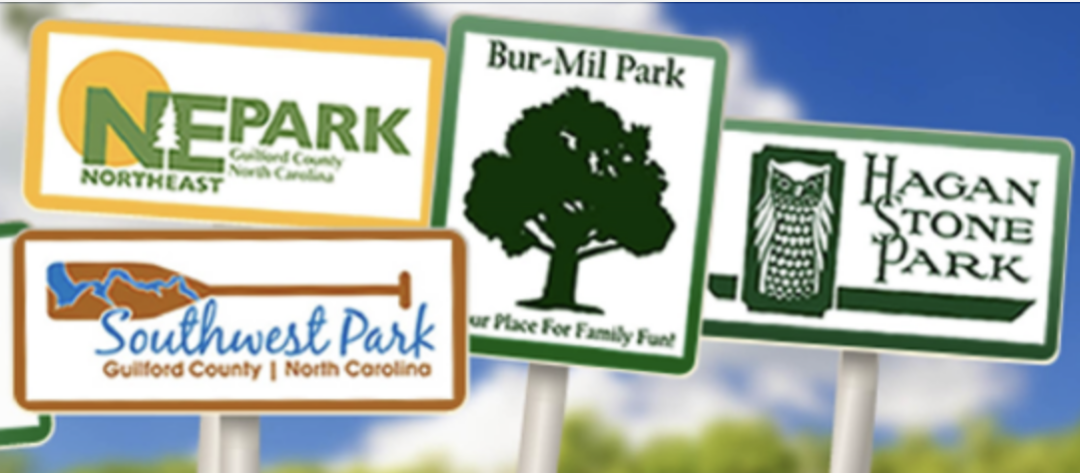On Thursday, Oct. 16, the Guilford County Board of Commissioners sat through a long and detailed work session in the third-floor conference room of the county-owned Truist Building in downtown Greensboro. The subject was the future of county parks – and in the end the commissioners approved in principle the Guilford County Parks, Trails and Open Space Master Plan. It’s something that’s going to greatly enhance the county’s parks but that will also cost a pretty penny.
County Parks Director Dwight Godwin kicked things off with a presentation he said he was “happy today” to bring to the board. He told commissioners the new plan – “From Survival to Success” – is a 10-year roadmap for moving the county’s 6,000 acres of parks and trails into the future.
Godwin described the system’s uniqueness compared to city parks departments – it stretches over a large geographic area across multiple towns, serves a diverse population, and depends heavily on partnerships with municipalities, nonprofits and businesses.
Godwin drew a distinction between “passive” parks – those with hiking trails, benches and open space – and “active” parks with facilities for volleyball, pickleball, aquatics and large-scale events.
He said both were important and both needed to get some attention going forward.
In the last decade and a half, the county has built or renovated a number of parks facilities – including an aquatic center with a capacity for 350 swimmers and volleyball courts at Bur-Mil Park.
The county has also added 1,500 acres of parkland over the last decade.
Godwin said the new master plan represents the culmination of two years of work, during which the county commissioners had been kept in the loop. He thanked the parks advisory board, which had unanimously approved the recommendations.
The stated goals of the plan include raising awareness of county parks, improving visibility among residents and elected officials, and tackling what he called “aging park infrastructure.”
Godwin turned the mike over to an outside consultant, who walked commissioners through the process.
She reminded the board that the project began in October 2023 and was now finishing in October 2025.
She said the effort had four stages – inventory and analysis, visioning, recommendations, and action planning. She called it “an intense two-year process” with the central question being where the department is now, where it wants to go, and how the county should get there.
The consultant said that Guilford County had engaged more than 2,000 residents through surveys, online input, library and recreation center events, and through booths at festivals like the Bur-Mil Fall Fest. Surveys, she said, showed that trails, fitness facilities, and outdoor music ranked as top priorities among county residents.
“Our team visited each of the county parks and evaluated their condition,” she said. “We looked at physical elements like parking lots and trails as well as the visitor experience.”
She added that the results placed some facilities in the “superior” category but showed many aging structures and playgrounds that need replacement. Accessibility improvements, historic structure preservation and basic building repairs also ranked high on the county’s needs list.
The consultant added that Guilford County’s 27 miles of county-maintained greenways are a highlight – especially the Bicentennial Greenway – and the master plan calls for extending connections with other trails and municipalities.
She noted that Guilford’s parks operating expenditures compare well to national standards. Staffing levels, however, are far below average, and most peer counties have larger workforces.
She described the plan’s guiding values as transparency, accessibility, outcomes, excellence, and added “our people matter.” She said the system’s strengths include its natural resource base and variety of amenities – while weaknesses include lack of vision at some parks, maintenance needs, and insufficient communication with residents.
According to the masterplan, Bur-Mil Park needs $2.6 million for accessibility, pool work and playground replacement. Gibson Park needs $1.1 million for pathway upgrades, bridge repairs and building fixes. Hagan-Stone Park requires $1.4 million, Northeast Park $2 million, and Southwest Park $1.6 million.
Across the board, the consultant said, electrical work, drainage fixes, playground replacements and historic preservation will take a good deal of time and money.
“This is not the finish line,” she said.
“This is the beginning of an evolving system,” she concluded.
Godwin returned to the microphone to stress staffing and operational needs. He said the county has 32 full-time employees covering over 6,000 acres, which amounts to 45 percent of what’s needed.
“The plan calls for a minimum of two or three positions per year to maintain high quality,” he said. “We’re currently operating with a $4 million budget. To move from survival to success we need $10 million.”
He laid out a three-part framework: staffing, operations and capital expansion. He said that, in the short-term, staff would focus on greenways, in the mid-term they would tackle deferred maintenance, and, in the long term, they would aim to arrive at “a comparable staffing model” with other counties.
Guilford County Manager Victor Isler told the commissioners that the budget process would be “structurally sound” and that they would see different options for capital funding over the next few years.
Budget Director Toy Beeninga said Guilford County’s parks budget now has $200,000 for equipment replacement, $72,000 for routine maintenance, $60,000 for greenway repairs, and $6,000 for pond restoration.
He stressed that there’s “no current dedicated recurring funding for parks capital.”
The master plan identifies $2.8 million in deferred needs, $6 million in renovation needs, and recommends setting aside about $300,000 a year to stay ahead of future repairs.
Beeninga noted other counties dedicate recurring revenue for parks capital – Forsyth County at $1.5 million annually, Durham County at $500,000.
“This seems to be a best practice,” he said.
Commissioner Mary Beth Murphy, who serves on the county’s parks and rec board praised the plan for taking a lot of input from citizens.
“I’ve been incredibly impressed by the level of community engagement – over 2,000 individual engagements, which I think is remarkable,” Murphy said. “It’s clear that our park system is one our community values greatly.”
Commissioner Kay Cashion said she hears regularly from residents about parks.
“I hear from the public they want them to be more active,” she said. “Parks are one of our greatest assets. People who come here from somewhere else can’t believe how beautiful they are.”
She said the need for an enhanced, up-to-date and vibrant parks system is all the more important given the huge influx of people and jobs on the way to the county.
Tillman added that many residents don’t know whether a park belongs to the county or to a city, and he also said that communication by all players will be important as investments move forward.
The board gave county staff the vote to move forward on the master plan, but Tillman made sure before casting his vote that at this point voting to progress the plan is “non-binding.”
In other words, the commissioners will have to vote again before they start shelling out all those millions.
Parks staff is likely to bring funding proposals up as part of the 2026-2027 budget process next spring and summer.
The work session ended with commissioners thanking staff and thanking the consultants.



“The consultant said that Guilford County had engaged more than 2,000 residents through surveys, online input, library and recreation center events, and through booths at festivals like the Bur-Mil Fall Fest.””
Wow ! 2,000 residents, that’s a lower percentage than those of us that voted in the primary.
All the additions and upgrades will make it easier for the people who choose to be homeless to settle in.
Maybe you should just build some new housing and count it towards your 10,000 houses. At least then you’ll collect your insanely high taxes.
Do you feel do-gooder about this? How about ten mil in property tax relief for ALL?
Love the parks. Maybe we can raise money by selling merchandise. Also, let’s engage volunteers like Boy Scouts. The entire Appalachian Trail, 2,200 miles, was once maintained by volunteers.
Property taxes go boom!
I fully support the parks, and the process of surveying users (and taxpayers) to ascertain how best to manage and maintain them. While not everyone may use the parks, anyone can and most would enjoy them. The same process should be applied to all significant county expenditures. How many people want them (including the taxpayers who fund them)? Guilford County is neither a welfare organization nor a private employer competing for staff. It is a public partnership of citizens, taxpayers and employers, all of whom have a stake in the future for themselves and everyone else who lives here. We do not need to be led to the future. We need to participate in the direction of the future, and have all inputs and views respected.